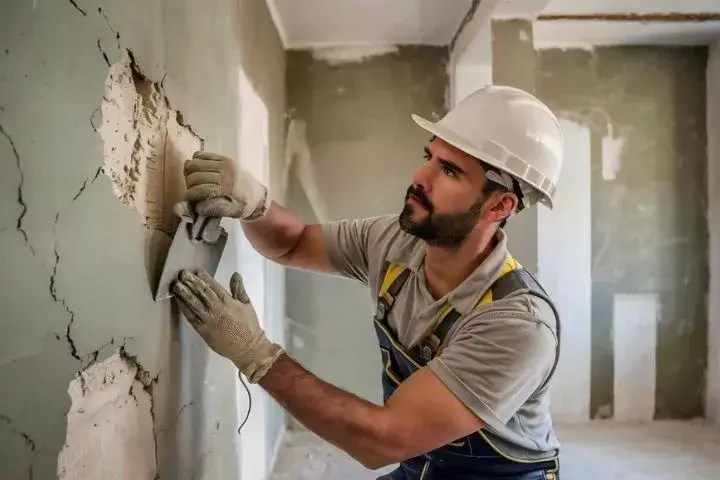Understanding the Essential Methods of Smudging for Home Renovation Projects
In the world of home improvement, mastering the necessary methods of gluing can substantially improve both the functionality and visual charm of a room. The gluing procedure encompasses critical stages, from thorough surface area preparation to the specific application of materials.
Sorts Of Plastering Methods
Although various smudging techniques exist, each offers an unique objective and uses distinct aesthetic qualities. One of one of the most usual approaches is typical lime plastering, which is recognized for its breathability and flexibility. This technique is specifically valuable for older structures, permitting wetness to run away while preserving structural honesty.
One more extensively used technique is plaster plastering, which entails the application of a quick-setting substance. It provides a smooth finish and is optimal for interior wall surfaces and ceilings, making it a preferred selection in modern-day building. For a much more textured look, trowel-on plastering techniques such as stucco and Venetian plaster are typically used. Stucco, generally used in outsides, offers resilience and weather resistance, while Venetian plaster is renowned for its elegant, refined finish.
Additionally, there are much more specialized techniques, such as skimming, which is a procedure that entails applying a thin layer of plaster over existing surfaces to develop a smooth surface. Each of these techniques can considerably affect the general visual and performance of a room, making it necessary to pick the ideal approach based upon the specific demands of a task.

Tools and Products Needed

The hawk serves as a platform to hold the plaster, while the trowels, offered in numerous dimensions, are vital for application and smoothing. A float, usually made of rubber or sponge, is made use of to achieve an uniform surface.

Protective gear can not be ignored; safety and security masks, handwear covers, and goggles are important to safeguard against dirt and particles. Finally, a tough ladder might be required for getting to greater areas, ensuring safety while operating at elevation. Spending in top quality devices and products eventually adds to a more effective gluing project, producing a durable and cosmetically pleasing surface. Appropriately furnished, you prepared for reliable gluing and home improvement.
Step-by-Step Plastering Refine
With the right devices and materials in hand, the next stage involves performing the plastering procedure with precision. Begin by preparing the surface to ensure optimum attachment. Get rid of any kind of loose particles, dust, or old plaster, and use a bonding representative if necessary.
As soon as the surface area is prepped, blend the plaster according to the maker's directions, accomplishing a smooth, lump-free consistency. Utilizing a trowel, use the very first layer, called the scrape coat, to a density of regarding 5-10 mm. Make certain consistent insurance coverage, and utilize a comb or scratcher to produce grooves for far better adhesion of succeeding layers.
After allowing the scratch coat to set partially, use the browse this site second layer, or the brown coat, smoothing it out for an even surface. Use the finishing layer, which need to be thinner and smoother.
Once the plaster has actually dried thoroughly, it can be sanded lightly to remove imperfections. Comply with up with a primer prior to painting for a refined last look.
Common Errors to Stay Clear Of
Stopping working to recognize common blunders can significantly impact the quality of your plastering task. Neglecting to repair any kind of underlying concerns, such see post as moisture or structural damages, can compromise the plaster's integrity.

Timing is also critical; many unskilled plasterers rush the application. Permitting the preliminary layer to dry entirely prior to applying succeeding layers is important to avoid excessive splitting and shrinkage.
In enhancement, not using the right tools can hinder the finishing procedure. Using trowels that are tiny or too big can affect your control and the level of smoothness of the finish.
Tips for Finishing Touches
Achieving a perfect finish in plastering calls for focus to detail and a couple of tactical methods. Once the first application has actually dried out, begin the ending up procedure by making use of a damp sponge or trowel to ravel any flaws. This step not only boosts the surface area yet likewise helps to eliminate any excess plaster that might have dried out unevenly.
Following, take into consideration making use of a fine-grit sanding block or pole sander for a much more sleek look. Fining sand should be done gently to stay clear of damaging the underlying layer - Plastering. Always wear a mask to safeguard against dirt inhalation
After fining sand, evaluate the surface area under various lighting conditions to recognize any missed variances or areas. Apply a slim layer of ending up plaster if necessary, feathering out the sides to mix effortlessly with the bordering area.
Final Thought
In final thought, understanding necessary plastering strategies substantially enhances the high quality of home enhancement tasks. Understanding the different kinds of gluing approaches, utilizing suitable devices and materials, and sticking to an organized application process contribute Our site to attaining a resilient and smooth coating.
In the world of home renovation, grasping the important strategies of gluing can dramatically enhance both the performance and visual allure of an area.Although various plastering strategies exist, each offers an one-of-a-kind objective and supplies distinctive aesthetic top qualities. Plastering. For a more textured look, trowel-on plastering strategies such as stucco and Venetian plaster are usually utilized. Stucco, commonly made use of in exteriors, gives resilience and weather condition resistance, while Venetian plaster is renowned for its lavish, sleek finish
Commonly used plaster types consist of gypsum plaster, lime plaster, and cement-based plaster, each serving various functions and environments.